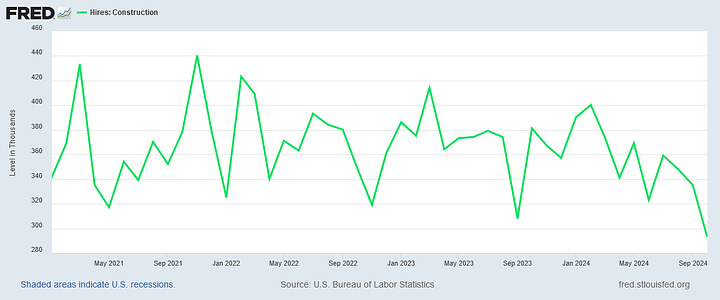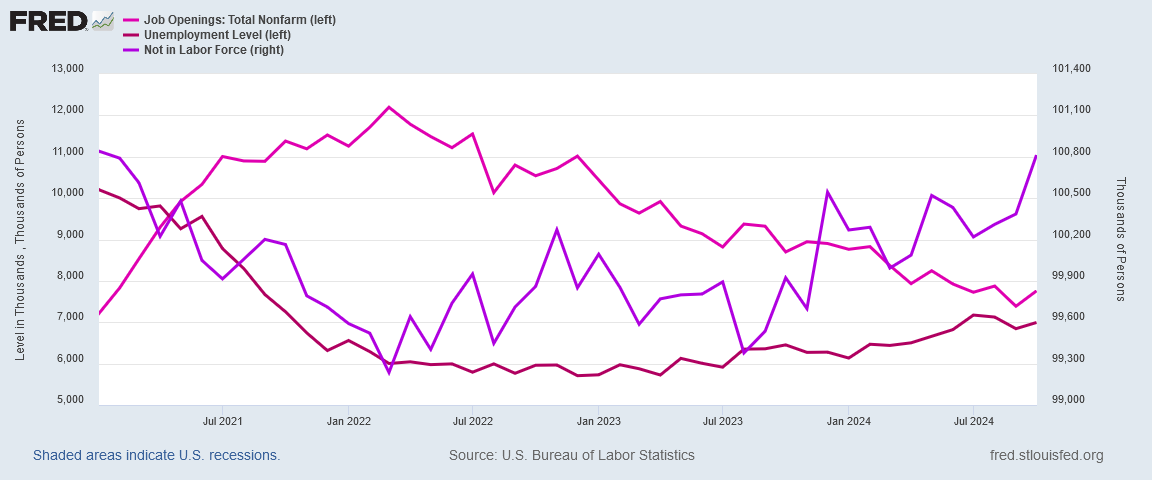According to the Bureau of Labor Statistics in their October Job Openings and Labor Turnover Summary Report, the jobs situation in the US is “little changed.”
The number of job openings was little changed at 7.7 million on the last business day of October, the U.S. Bureau of Labor Statistics reported today. Over the month, hires changed little at 5.3 million. The number of total separations was little changed at 5.3 million. Within separations, quits (3.3 million) increased, but layoffs and discharges (1.6 million) changed little. This release includes estimates of the number and rate of job openings, hires, and separations for the total nonfarm sector, by industry, and by establishment size class.
When things are “little changed” in an economy, that generally implies a level of stagnation, and decline is not already happening it is very likely on the verge of happening.
A closer look at the JOLTS report shows us that decline is indeed what is happening with hiring in this country. And that’s not a good thing.
While the JOLTS report perhaps reflexively is focused on the current month, if we take a step back and look at the data across the entirety of the (Biden-)Harris Administration, “decline” is exactly what we see.
The number of presumed job openings in this country peaked in early 2022, and has trended down ever since. The increase in October was not at all large enough to break out of that that trend, suggesting that the decline is continuing.
Perhaps even more disconcerting is that the reported number of job openings rose by 372,000, while the number of actual hires declined by 269,000 in October. Despite companies having quite a few additional jobs to fill, they are not even able to fulfill the ones they have.
As we have seen nearly every month for quite some time, if we focus on the hiring numbers—those job openings which actually got filled—we see that the downward trend in hiring has not abated since it began in February of 2022.
For all the much bally-hooed “job openings”, companies have been hiring fewer and fewer workers almost every month for close to three years.
What is perhaps even more disconcerting, however, is that the number of Quits—those individuals who voluntarily leave their jobs for whatever reason—has been on the decline but the number of layoffs has been trending up.
People are less certain about their job security, it seems, and are increasingly reluctant to change jobs. At the same time, businesses are increasingly reluctant to keep workers on, and so are having more and more layoffs.
Neither of these trends are at all signs of healthy labor markets in the United States.
In a further confirmation of the weakening manufacturing sector in this country, looking at the sector-level information shows that manufacturing hiring also had peaked in 2022.
Ever since 2022, manufacturing firms have been hiring fewer and fewer workers.
Again, this is not a healthy trend for any economy, or for any economic sector.
Moreover, the downward trend in hiring spans nearly the entire economy, with very nearly every sector showing at least some hiring decline since the start of the (Biden-)Harris Administration.





Only in the area of Private Education and Health Services do we see a rising hiring trend.
That is it. That is the only economic sector posting a rise in hiring since 2021. Even the government has been hiring fewer and fewer workers each month going back to at least the start of 2022.
Nor can we say that it is simply a question of hiring slowing in various sectors. When we look at the net hiring (Hires less Total Separations) for manufacturing since 2021, we see that manufacturing has had multiple months especially in 2023 and 2024 where the net hiring was negative—i.e., there was job loss in manufacturing.
This also provides another signal that the US has been in a jobs recession arguably going back into 2022, but certainly for most of 2023 and 2024.
The weakness in the US job markets is demonstrated even further when we compare the job openings data to the overall unemployment level in this country.
If job openings were actually being filled, the declining job openings trend would be accompanied by a declining unemployment trend. Instead, as job openings have declined, unemployment levels have risen.
Arguably, that data shows that there are simply fewer and fewer jobs available in the US, although there are more and more workers looking for work. Those who do not find work are what constitute the unemployed.
When we factor in those not in the labor force, this pattern of declining job opportunities is magnified.
As the number of reported job openings has declined, the ranks of the unemployed have risen and the number of individuals not in the labor force has risen. There are few ways to interpret such a signal as anything other than there are simply fewer and fewer job opportunities for individuals.
Nor can we simply ascribe this pattern to being an artifact of exaggerated job openings data. If we make the comparison using the hiring data instead, we see the same correlation: hiring has declined as unemployment has risen, and as the number of workers not in the labor force has risen.
From every angle, the data tells a tale of less hiring and less opportunity.
This is the JOLTS data the BLS says is “little changed.”
In large measure, the BLS is not wrong to point this out. There is not dramatic change in the jobs data. The trends that were in evidence in September were largely continued in October. Those trends have not changed, and the datapoints themselves have shifted accordingly.
However, what gets ignored by that observation is that these trends which the BLS says are “little changed” are not good trends. What goes unsaid is that these trends are all trends which speak of fewer jobs and fewer job opportunities.
These are trends which make a case for saying the United States has been in recession for a couple of years now, and that the recession—what I call a “jobs recession”—is likely to get worse before it gets better.
The JOLTS report says things are “little changed” in US job markets. Unfortunately for workers, ‘little changed” fundamentally means “less hiring.”
That’s not a good thing. Not at all.













And today’s local layoff victims:
https://www.startribune.com/solventum-laying-off-workers-ceo-message/601190733
Peter, as usual, you are correct in your assessment!
Annnd the “healthy economy” continues today:
https://www.startribune.com/cargill-layoffs-8000-5-percent-global-workforce-minnesota-ag-trader-minnetonka-hq/601190081